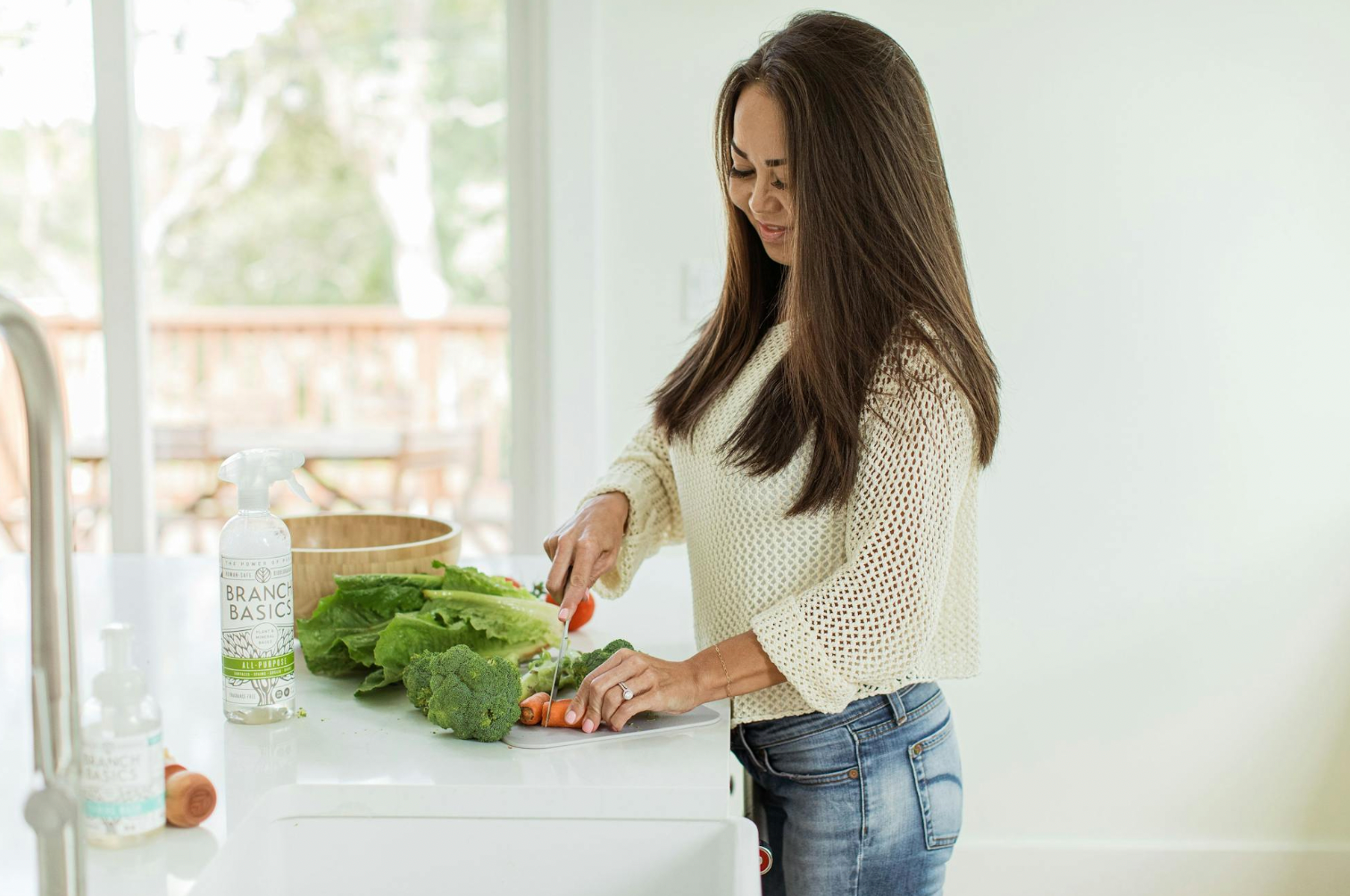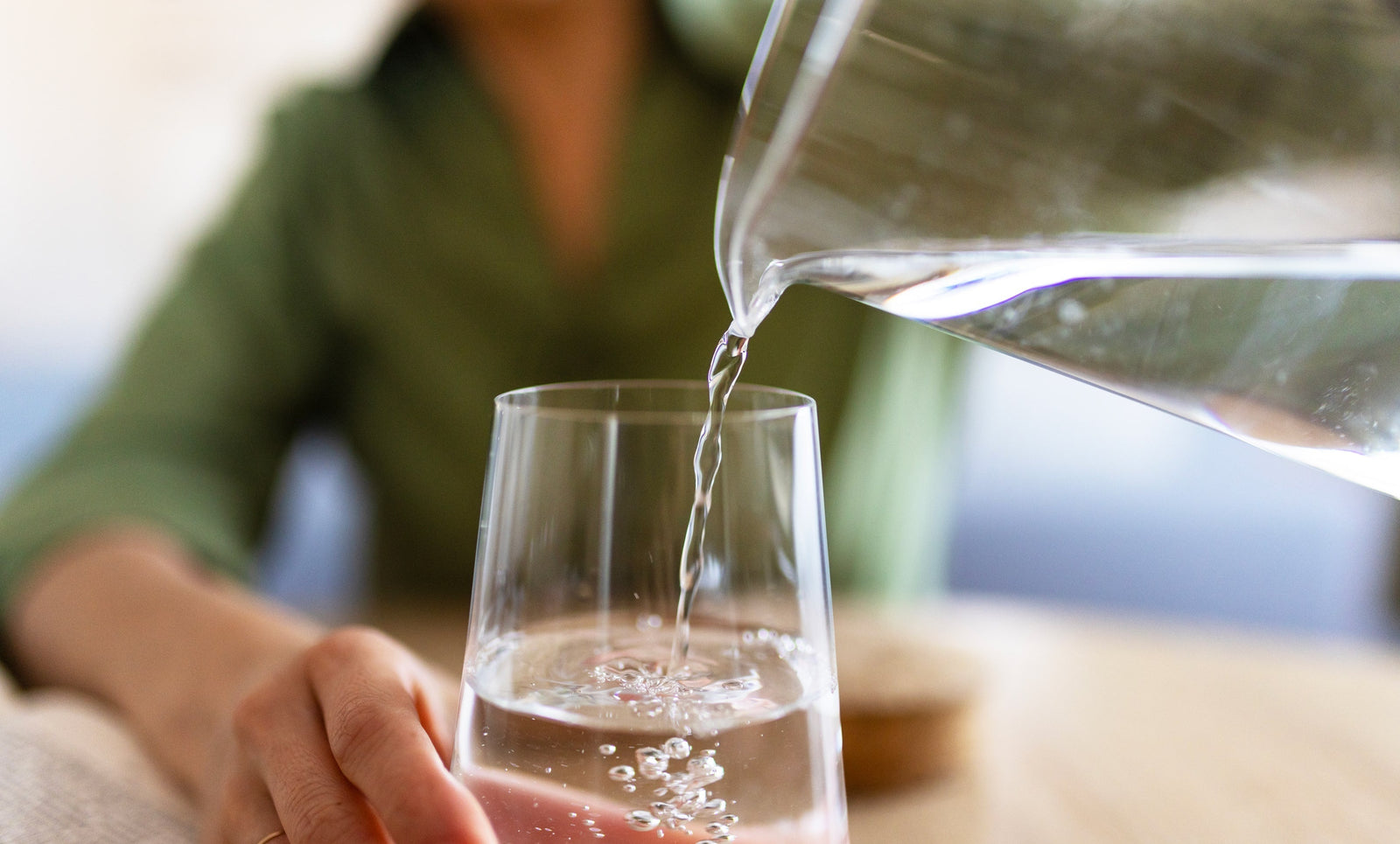How To Remove Pesticides From Leafy Vegetables

Leafy greens are a rich source of vitamins, minerals, antioxidants, and other health-promoting, disease-fighting nutrients.
Unfortunately, many of these emerald beauties can be high in pesticide residues.
Does this mean you should avoid putting kale or spinach in your smoothies? Heck no!
In this article, we share the best ways to remove pesticide residues from leafy green vegetables and helpful consumer advocate tools to help you vet the healthiest produce.
Why It’s Important To Wash Leafy Vegetables
Washing produce is an essential part of eating healthfully, preventing food poisoning and disease, and reducing pesticide exposure.
Yet many Americans forgo washing their produce before eating or cooking.
As working mamas, we know how helpful time-savers are when trying to get a meal on the table after a long day.
But skipping produce washing is like playing Russian roulette in terms of contamination and pesticide exposure, especially when it comes to leafy vegetables.
For example:
- In the last several years, how many times have you heard of recalls due to issues like E. Coli, listeria, or salmonella in conventional or organic spinach, Romaine lettuce, and salad kits?
- Imagine how many people—from farm to grocery store—have touched, breathed on, and otherwise handled your produce?
- Plus, leafy greens like spinach, kale, collards, and mustard greens have been consistently on the Environmental Working Group’s Dirty Dozen* list for several years.
*The Dirty Dozen is an annual list compiled by EWG where they test various fruit and vegetables to see which contain the lowest and highest pesticide residues.
Leafy greens’ delicate nature, along with controversial growing practices in commercial agriculture, like monocropping, make them a favorite of pests, fungi, and other plant diseases.
Therefore, conventionally grown leafy greens are vigorously sprayed with synthetic and persistent pesticides, herbicides, and fungicides.
From cleaning products to lawn care, food to pest control, the harmful cumulative effects of pesticide exposure, from cancer to developmental disorders, are just beginning to be understood.
This is why buying organic should always be a priority, but washing your leafy vegetables—and all produce—is vital to remove as many bacteria, germs, viruses, parasites, and pesticide residues as possible.
Removing Pesticides From Leafy Vegetables: 3 Methods
Removing pesticides from leafy greens is challenging because they cannot be vigorously scrubbed or peeled like other produce.
Yet, as you’ve just learned, proper cleaning to reduce pesticide exposure is essential.
To be clear, no known method exists to reduce 100% of pesticide residues.
The best way to avoid pesticides altogether is to buy organic, grow it yourself, or buy from a certified-naturally-grown farm.
However, when this isn’t possible, use one of these methods to remove as much pesticide residue as possible.
1. Clean Running Water
Cool running water is considered the most effective way to remove dirt, debris, germs, and pesticide residue from fruits and vegetables, including leafy greens.
A recent 2022 study titled: “Effectiveness of Different Washing Strategies on Pesticide Residue Removal: The First Comparative Study on Leafy Vegetables” showed rinsing under cool water was the most effective method of the nine methods studied.
We recommend using filtered water if possible, but regardless, always rinse your fruits and veggies.
Here’s how to wash leafy greens under cool, clean water.
- Separate your leafy greens in a clean colander and place in a clean sink.*
- Some experts believe the kitchen sink is the dirtiest and germiest place in the home! So clean your kitchen sink before washing any raw produce.
- Discard any discolored or slimy-looking leaves and remove the outer leaves for extra protection.
- Gently rinse in running water for at least a minute.
- Spin dry and store in a clean, plastic-free container.
Healthy home tip: Mason jars or glass storage containers are excellent for storing leafy greens without worrying about plastic chemicals leaching from bags or containers.
To learn more, check out Switching to Glass: The Best Way to Store Food & Drinks to Avoid Phthalate and BPA Exposure.
2. Branch Basics + Clean Running Water
Why include Branch Basics for removing pesticides when running water works so well?
#1: Friction removes more contaminants than rinsing alone.
That’s why experts recommend scrubbing hard-skinned produce like apples or potatoes—it removes more dirt, germs, and pesticides than just rinsing.
#2: Some pesticides used on leafy vegetables are hydrophobic, meaning they are designed to repel water, making rinsing alone ineffective for these pesticides.
Branch Basics naturally-derived surfactants, like coco and decyl-glucoside, are designed to break down hydrophobic substances.
The previously mentioned study on effective ways to remove pesticide residue from leafy greens found detergents (which are made up of surfactants) were effective in dissolving non-polar pesticides organochlorines (hexachlorobenzene, α-hexachlorocyclohexane) and organophosphorus (chlorpyrifos, fenitrothion) are examples of non-polar pesticides.
This study was not conducted using Branch Basics, but it suggests surfactants are valuable in removing pesticide residue.
The key is using human-safe, natural, or naturally-derived surfactants that won’t add more chemical residue to your greens.
#3: Soap and water, like Branch Basics, have been shown to effectively break down viruses, by disrupting their lipid layer.
This doesn’t relate to pesticide residue, but it’s another good reason to clean your greens with Branch Basics or another natural soap dilution.
Here’s how to use Branch Basics to clean your leafy greens without a soapy residue:
- Rinse leafy greens under cool running water, as described in the previous section.
- Lightly spray your greens with Branch Basics All-Purpose dilution.
- Gently rub onto the greens.
- Rinse again with cool water.
- Store in a glass storage container.
Note: We recommend spraying versus soaking because experts warn that soaking a contaminated vegetable could spread the containment around. This is especially true for leafy greens with all their nooks and crevices.
Greens could also become contaminated if soaked in an unclean/unsanitized sink or other receptacle.
Many natural living experts swear by various soaking methods; we like them for tougher vegetables, especially fruits like apples (side note: research has shown soaking apples in baking soda is the most effective way to remove pesticides!). However, spraying and rinsing is the best method for delicate leafy greens.
Related read: How To Keep Produce Fresher Longer [Complete Guide]
3. Vinegar Spray
Vinegar is one of the best non-toxic cleaning allies you can have in the kitchen.
It has many uses, from descaling small appliances as an all-purpose cleaner and a produce spray.
In addition, research has shown it effectively kills some food-borne pathogens, including E.Coli, salmonella, and listeria.
Research has shown 5% vinegar (such as distilled white vinegar) also helps remove pesticide residue from leafy greens.
Here’s how to use a vinegar spray to clean leafy greens naturally:
- Rinse leafy greens under cool running water, as described in the previous section.
- Pour 1 cup of vinegar into 3-4 cups water.
- Spray greens - (avoid inhaling the fumes from the vinegar when spraying.
- Gently rub onto the greens.
- Rinse again with cool water.
- Store in a glass storage container.
Discover more incredible ways to use vinegar for non-toxic cleaning in: 12 Ways To Use Vinegar In Your Home.
Note: Vinegar contains acetic acid, a lung irritant when sprayed. Use it in a ventilated area, and try not to inhale the freshly sprayed vinegar. Do not spray vinegar in the presence of children, the elderly, and those with lung or chronic health conditions.
Going Pesticide-Free: How to Clear Your Home
Lowering your pesticide exposure is foundational to a healthy lifestyle and preventing various chronic and deadly diseases.
It’s especially important for homes with children who are more susceptible to the negative impacts of acute and chronic exposure.
As mentioned above, pesticides don’t just enter our homes on produce. They can also be found in pest control sprays, cleaning products (bleach, for example, is an EPA-registered pesticide), pet products, tracked-in shoes, and clothing and building materials.
Yes, pesticides may be everywhere, but the situation is far from hopeless!
Fortunately, you have the power to dramatically decrease your pesticide exposure by making a few simple changes and substitutions in and around your home.
Learn all about it in: How To Remove Pesticides From Your Home in 8 Simple Steps.
FAQs
Who knew washing leafy greens could be such a big topic?! Here, we answer some FAQs to help further empower you to remove pesticide residues safely.
Should I Wash Bagged Vegetables And Salads?
This is controversial, but our opinion is a hard and fast YES.
As you’ve likely noticed, most of the leafy green vegetable recalls have been for salad kits and bagged or pre-cut veggies…which are supposed to be triple-washed and “the safest” option.
Well, if they were so safe, why so many recalls?
Ideally, we recommend against buying salad kits or bagged veggies and instead making/chopping your own.
However, if you need to buy them for convenience, please wash thoroughly using one of the healthy and safe methods listed above.
Not only are they more likely to be contaminated, but they could have been washed in a factory using bleach or other less-than-natural cleaning agents that could leave more residue.
Do Baking Soda And Vinegar Really Remove Pesticides?
Yes!
Although we didn’t list baking soda here because it requires use as a soak (spraying vs. soaking is better for leafy greens), the aforementioned Korean study showed that baking soda and vinegar were effective in removing pesticide residues.
Baking soda has also been shown effective in other studies, including the one we mentioned on pesticide removal from conventional apples.
Do Pesticides Soak Into Fruits And Vegetables?
It depends on the fruit or vegetable.
More porous, thin-skinned fruits and veggies, like nectarines and leafy greens, are much more likely to contain pesticide residue than thick-skinned cousins, like winter squash or avocados.
Pesticides can also enter a plant via the roots or seeds, and no amount of washing or produce wash can fix that.
This is why we recommend buying organic or certified naturally-grown produce whenever possible.
If this isn’t an option, avoid the Dirty Dozen, buy more of the Clean Fifteen, and wash everything (organic or not) using one of these healthy & safe methods.
Make The Switch to Pesticide-Free With Branch Basics
In addition to washing produce and buying organic, switching from synthetic chemical cleaners to human-safe cleaning and laundry products is one of the most powerful ways to reduce your daily pesticide exposure.
If you’re interested in tossing the toxins and trying Branch Basics as a produce wash and cleaning system, check out our Starter Kits.
Our human-safe, natural, Made-safe, biodegradable, non-GMO, and EWG-verified cleaning line was designed to replace all the cleaning and laundry products with just one Concentrate.
Simply add water to create All-Purpose (which can also be used as a produce spray), Bathroom, Streak-Free, Laundry, and Foaming Wash.
To learn more about what’s in Branch Basics and how it works, see: How To Get Started With Your Branch Basics Kit, and reduce your pesticide burden right now.
Categories

Marilee Nelson
Marilee Nelson is an Environmental Toxins expert who has spent nearly 30 years advocating for the chemically-sensitive and chronically-ill. She is a Board Certified Nutritionist, Certified Bau-Biologist and Bau-Biology Inspector and specializes in Food As Medicine. She has helped thousands of families and individuals identify, heal and recover from toxic exposures and is on a mission to revolutionize the way American families view their health.








